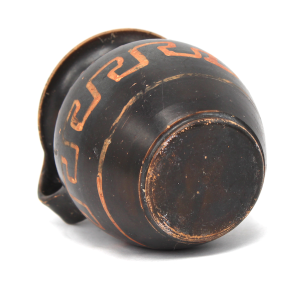Ancient Daunian Earthenware Cup, Magna Graecia, Italy (1789LME) $595
$595.00H: 3” W: 4.75” D: 4” | FREE SHIPPING IN CONTINENTAL U.S.!
This Daunian style earthenware cup was produced in the ancient northern Italian region Apulia, then known as Magna Graecia, from the 6th or 5th centuries B.C.E.. It was covered with beige slip and painted with red, brown and black earth colors in a variety of geometric patterns. Its curved rim and high handle was ideal for pouring liquids like water and wine. The handle may have been repaired as there is an uneven slip underneath it or may have been attached it was painted but it is otherwise in very good condition.






